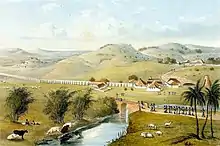Trinity plantation
Trinity was a plantation in colonial Jamaica, located south of Port Maria, in Saint Mary Parish, one of several plantations owned by Zachary Bayly that formed part of the area known as Bayly's Vale. By the early nineteenth century, over 1,000 people were enslaved there producing mainly sugar and rum for which a mile-long aqueduct was built by Nathaniel Bayly to supply water for the refining process.



In 1760, slaves from Trinity started a rebellion which grew to over 400 slaves, but was put down with troops sent by the Governor.
History
Ownership
Among the earliest owners of Trinity plantation were Isaac Gale (died 1748),[4] and Zachary Bayly (died 1769),[5] who also owned the Tryall, Brimmer Hall, and Roslyn plantations, which formed one contiguous area of around 4-5,000 acres known as Bayly's Vale.[6]
After Zachary Bayly's death, Trinity passed into the ownership of his nephew Bryan Edwards (died 1800), his brother Nathaniel Bayly (died 1798), and his son Charles Nathaniel Bayly,[7] the nephew of Zachary Bayly. After the Baylys, the plantation came under the control of the merchant and banker Job Mathew Raikes, who married Charlotte Bayly, daughter of Nathaniel Bayly.[8] Raikes died in 1833, the same year that slavery was abolished in the British Empire by the Slavery Abolition Act, compensation being paid to his executors in 1837 of £4,026 in respect of 212 enslaved persons at Trinity.[9][10]
Aqueduct and production
A good water supply was necessary for sugar refining and Trinity was located at the confluence of the Port Maria Western River, now the Otram River, and the Negro River. In addition, Nathaniel Bayly built an aqueduct, completed in 1797, of over a mile's length from Port Maria Western River to Trinity.[11] It is shown centrally in James Hakewill's illustration of the plantation with the Brimmer Hall works and overseer's house in the background.
Hakewill wrote that the area produced 1,000-1,100 hogsheads of sugar annually and in 1815 had produced 1,450 with a population of around 1,100 slaves.[12] The principal products of the plantation were sugar and rum, but it also produced molasses, logwood, and cattle.[7]
Rebellion
In 1760 during Tacky's Rebellion, about 50 slaves rebelled and marched on Port Maria where they seized weapons. They were mostly from Trinity plantation but also from Whitehall, Frontier, and Heywood Hall. According to Edward Long, their number grew to around 400 before the rebellion was put down with help from troops sent by the Governor.[13]
Final sale
In 1874, Trinity came up for sale at auction in London by order of the Court of the Commissioners for Sale of Incumbered Estates in the West Indies. The sale particulars stated that it was of 816 acres with 227 under cultivation, with 111 animals, mostly steers, and multiple buildings and machinery.[14]
Legacy
A settlement named Trinity still exists. Other local features are Bailey's Vale Road, Brimmer Vale High School, and the settlement of Tryall.[15]
See also
References
- Hakewill, James. (1825) A Picturesque Tour of the Island of Jamaica, From Drawings Made in the Years 1820 and 1821. London: Hurst and Robinson & E. Lloyd. Plate 12.
- Map of the County of Middlesex & c. James Robertson, 1804. National Library of Scotland. Retrieved 17 May 2019.
- "Jamaica, particulars and conditions of sale of valuable Sugar Estate : known as "Trinity Plantation," "Roslyn Pen," "Cromwell Plantation," and Cromwell Mountain," all sutuate in the Parish of St. Mary &c." Library of Congress. Retrieved 20 May 2019.
- Isaac Gale of St Elizabeth. Legacies of British Slave-ownership, UCL. Retrieved 16 May 2019.
- Zachary Bayly. Legacies of British Slave-ownership, University College London. Retrieved 16 May 2019.
- "The Letters of Simon Taylor of Jamaica to Chaloner Arcedekne, 1765-1775" edited by Betty Wood et al in Betty Wood & Martin Lynn (Eds.) (2002). Travel, Trade and Power in the Atlantic 1765-1884. Camden Fifth Series Vol. 19. Miscellany XXXV. Cambridge: Cambridge University Press. pp. 1–164 (pp. 16-17). ISBN 0521823129.CS1 maint: extra text: authors list (link)
- Trinity Estate. Legacies of British Slave-ownership, University College London. Retrieved 16 May 2019.
- Papers of Job Matthew Raikes as executor of the estate of Nathaniel Bayly (1726-98), West Indian plantation owner. Jisc Archives Hub. Retrieved 19 May 2019.
- Job Mathew Raikes. Legacies of British Slave-ownership, University College London. Retrieved 19 May 2019.
- Jamaica St Mary 265 (Trinity Estate). Legacies of British Slave-ownership, University College London. Retrieved 19 May 2019.
- Higman, B. W. (2001). Jamaica Surveyed: Plantation Maps and Plans of the Eighteenth and Nineteenth Centuries. Kingston: University of the West Indies Press. pp. 116–118. ISBN 978-976-640-113-9.
- "Trinity Estate", Hakewill, 1825.
- Long, Edward. (1774). The History of Jamaica or, General Survey of the Antient and Modern State of that Island &c. Vol. II. London: T. Lowndes. p. 448.
- Jamaica, Particulars and Conditions of Sale of Valuable Sugar Estates - known as "Trinity Plantation," "Roslyn Pen," "Cromwell Plantation," and Cromwell Mountain," all situate in the Parish of St. Mary. 25 November 1874. 2nd edition. London: Hards, Vaughan, & Jenkinson.
- Trinity. Google Maps. Retrieved 17 May 2019.
External links
 Media related to Trinity plantation at Wikimedia Commons
Media related to Trinity plantation at Wikimedia Commons